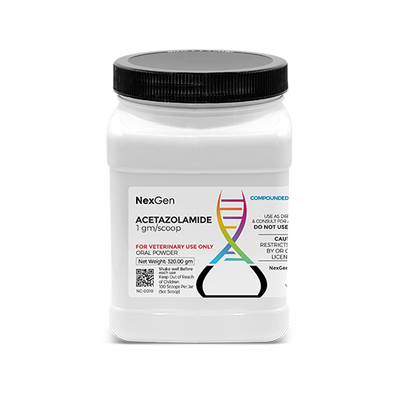
Cimetidine 1 gm/scoop, Oral Powder, 90 Scoops (5cc Scoop)
Login for pricing
- Brand
- Mixlab
- SKU:
- NC-0099
- Product Type:
- Powder
- Size:
- 32oz
- Administration:
- Oral
- Scoops Per Container:
- 90
- Scoop Size:
- 5cc
Cimetidine For Horses
Gastric ulcers can affect horses of any age, including foals. The literature holds that nearly 90% of racehorses and over 50% of non-performance horses suffer from this malady.1 Gastric ulcers arise when the lining of a horse’s stomach begins to become eroded due to prolonged exposure to stomach acid. There are several conditions which give rise to this; most of these are lifestyle-related. The repeated use of nonselective NSAIDs in horses also contributes to this syndrome.
Gastric ulcers—also called equine gastric ulcer syndrome (EGUS) are most closely associated with athletic horses, horses under inordinate stress and horses with comorbidities (other illness). “Prevalence in unmedicated racehorses in active training is at least 90%, whereas that in non-racing performance disciplines exceeds 60%. Neonatal foals are at significant risk for development of perforating peptic ulcers until they are several weeks old, because their gastric mucosa is not developed to full thickness at birth. Although spontaneous healing of peptic ulcer lesions has been noted, if the horse is maintained in the circumstances inciting EGUS, the lesions are unlikely to heal without medical intervention.”2
Ulcers and Equine Physiology
Horses are natural grazers, which means that they typically eat throughout the day. Thus, they have evolved to secrete stomach acid all day long. This becomes a problem due to the periodic feeding regimen of nearly all horses that work or perform for a living. There is less food in the horse’s stomach at most times during the day, as opposed to horses in a natural setting, and more time for stomach acid to work on the delicate stomach lining.
A horse’s stomach is comprised of two parts, representing upper and lower segments. The lower portion is glandular; it secretes stomach acid and has a protective coating to keep it from being damaged by acid. “Ulcers do occur in the glandular portion of the stomach, but this is less common. The top portion of the stomach is designed for mixing of the contents of the stomach and does not have as much protection from the acid. This is the most common place to find gastric ulcers.”1
Stall confinement is another culprit in this scenario. This aspect of horse husbandry causes stress, because horses are social animals that are unused to solitary living in their natural setting. It is said that stall confinement alone can lead to the occurrence of gastric ulcers, and that horses housed without direct contact to other horses and horses kept in urban areas are at very high risk to develop squamous gastric ulcers. When horses are fed two times a day (as so many are), the stomach lining is subjected to a prolonged period without feed to neutralize stomach acid. “Furthermore, high-grain diets produce volatile fatty acids that can contribute to the development of ulcers.”1
Cimetidine is a CLASS 5 DRUG under the Association of Racing Commissioners International (ARCI) Uniform Classification Guidelines for Foreign Substances (UCGFS).
Please consult your veterinarian before beginning any treatment regimen.
Where to buy Cimetidine
Cimetidine is available in the U.S. through several pharmaceutical manufacturers and through veterinary custom compounding companies.
FOR RX ONLY: A valid prescription from a licensed veterinarian is required for dispensing this medication.
1aaep.org.
2Merck Veterinary Manual.
















